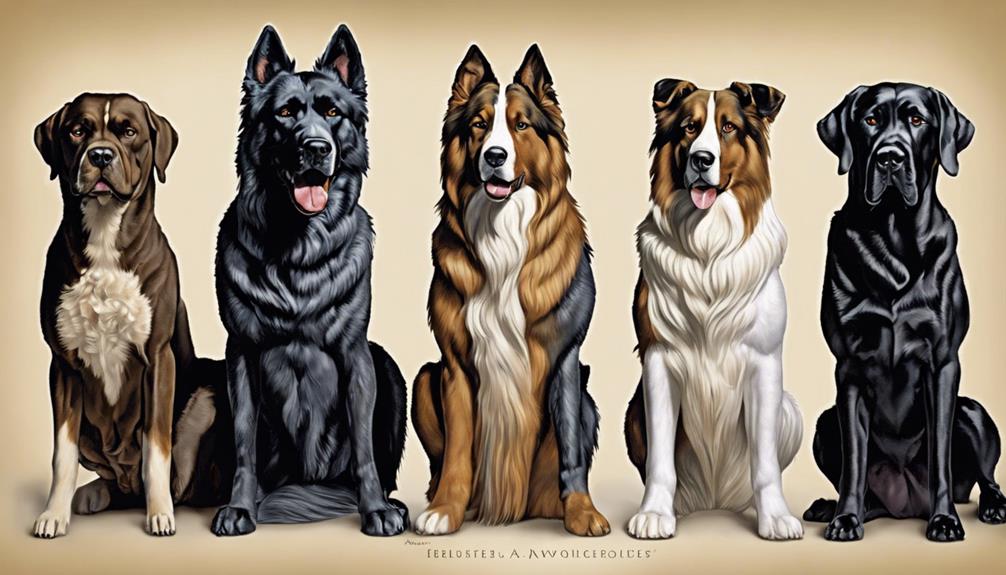When it comes to effectively training dogs using shock collars, it is crucial to understand the factors that impact the collar’s effectiveness. Considerations such as the dog’s size, breed sensitivity, and emotional state are important. Customizing the various collar options to match our furry companions, making gradual adjustments to settings, seeking advice from trusted trainers, and employing correct training methods with positive reinforcement are all key components in successful and humane training methods that help build a strong bond with our pets.
Key Takeaways
- Start training with positive reinforcement methods.
- Gradually introduce shock collar after clear communication.
- Apply stimulation fairly to avoid confusion.
- Use the lowest effective shock level.
- Monitor progress closely and reward desired behaviors.
Understanding Different Types of Shock Collars
When delving into the world of dog training with shock collars, it's essential to grasp the nuances of the various types available for specific training objectives. One key type is the remote training collar, which allows for effective training from a distance. These collars are versatile, offering features like vibration and tone modes alongside electric stimulation.
Vital reinforcement is a critical aspect of using shock collars to train our canine companions. By pairing the correction with rewards when the desired behavior is exhibited, we can enhance the training process. Additionally, electric stimulation collars are valuable tools for boundary reinforcement. They help establish safe zones for our pets, ensuring their well-being and preventing them from straying into potentially dangerous areas.
Understanding the different types of shock collars empowers us to tailor our training methods to suit our dogs' needs, making the training experience more effective and humane.
Factors Influencing Shock Collar Effectiveness

Factors that influence the effectiveness of shock collars in dog training vary based on the dog's size, breed, and individual sensitivity to stimulation. Understanding these factors is pivotal for achieving desired training outcomes.
Larger dogs, for instance, may require higher collar settings to respond effectively. Breed sensitivity also plays a significant role; some breeds may be more responsive to lower levels of stimulation compared to others. Additionally, emotional factors such as fear and anxiety can impact a dog's reaction to shock collar training, highlighting the importance of considering the dog's temperament during training.
To enhance the efficacy of shock collar training, it's vital to adjust the settings according to the specific needs and responses of each dog. By tailoring the stimulation levels to suit the individual dog, trainers can maximize the benefits of using shock collars as a training tool. Remember, every dog is unique, and recognizing these individual differences can make a significant difference in the success of shock collar training programs.
Adjusting Shock Collar Settings Appropriately
To guarantee successful training outcomes, it's essential to properly adjust shock collar settings based on your dog's individual characteristics such as size, breed, and sensitivity levels. Starting with the lowest shock level and gradually increasing only if necessary is important to avoid causing discomfort or distress. Monitoring your dog's response to the shock collar stimulation and making adjustments accordingly will lead to ideal training results. Consulting with a professional trainer to determine the appropriate shock collar settings for your dog's specific training needs is highly recommended. Additionally, regularly evaluating and fine-tuning the shock collar settings will help maintain consistency and effectiveness in your training sessions.
- Start with the lowest shock level: Begin with the mildest setting to gauge your dog's reaction.
- Monitor your dog's response: Observe how your dog reacts to the shock collar and adjust settings accordingly.
- Consult a professional trainer: Seek guidance from an expert to set the right shock collar levels for your dog.
- Fine-tune settings: Regularly refine the shock collar settings to ensure effective training.
- Optimize training sessions: Adjust settings as needed to enhance the quality of your training sessions.
Seeking Guidance From Experienced Trainers

Moving from adjusting shock collar settings appropriately, enlisting the help of a knowledgeable dog trainer is vital for mastering shock training. Experienced trainers offer invaluable expertise tailored to your dog's unique requirements, ensuring the correct application of shock collars for effective overall training. They can assist in determining appropriate intensity levels, teaching you to incorporate positive reinforcement techniques alongside shock collar usage.
Working closely with professionals not only enhances the effectiveness of shock training but also guarantees its safe and ethical implementation. By seeking guidance from experienced trainers, you can address any concerns or challenges that may arise during the training process, fostering a more successful and harmonious relationship with your dog.
When using a shock collar, make sure to consult with a qualified trainer to maximize training outcomes while prioritizing your dog's well-being. Trusting in the expertise of a seasoned professional can greatly elevate your training efforts and deepen the bond you share with your canine companion.
Ensuring Proper Training Techniques Are Employed
Let's make sure that the proper training techniques are employed when using shock collars to effectively guide your dog towards desired behaviors.
- Start with positive reinforcement to establish a foundation of desired behaviors.
- Introduce the remote collar gradually after clear communication is established.
- Consistently apply the remote collar fairly to prevent confusion or fear in your dog.
- Use the lowest effective level of stimulation to correct unwanted behaviors, adjusting as needed.
- Monitor your dog's progress closely and provide praise and rewards for desired behaviors to reinforce training.
Frequently Asked Questions
Do Shock Collars Really Help Train Dogs?
Yes, shock collars can be effective tools in training dogs when used properly. They provide immediate feedback for behaviors like barking or aggression. Understanding correct usage, including positive reinforcement, is essential to avoid harm and achieve desired results.
What Is the Best Way to Train a Dog With a Shock Collar?
We begin with positive reinforcement, gradually introducing the shock collar to avoid overwhelming the dog. Proper fit is essential for comfort. Use the collar as a final option, shifting to positive reinforcement for lasting results.
Can I Use a Shock Collar to Discipline My Dog?
Yes, we can use a shock collar to discipline a dog, but it should be a last resort. We must prioritize positive reinforcement and professional guidance. Understanding proper usage is essential to prevent harm and focus on behavior redirection.
Do Vets Recommend Shock Collars?
Certainly, some veterinarians do recommend shock collars in specific cases. However, they emphasize the importance of expert guidance and appropriate training methods. It's essential to consult a vet to guarantee your dog's well-being when contemplating shock collars.
Are Shock Collars Safe and Effective for Mastering Dog Training?
Effective dog shock collars have been a subject of debate for dog owners. While some tout their safety and efficiency in training, others argue that they can be harmful to canine companions. It is essential for pet owners to thoroughly research and consider the potential risks before using shock collars for training.
Conclusion
To sum up, mastering dog training with shock collars requires a thorough understanding of the different types available, the factors influencing their effectiveness, and the importance of adjusting settings appropriately.
Seeking guidance from experienced trainers and ensuring proper training techniques are employed are essential for successful outcomes.
Remember, a well-trained and happy dog is a reflection of the love and dedication you put into their training journey.










